FOOD & WINE
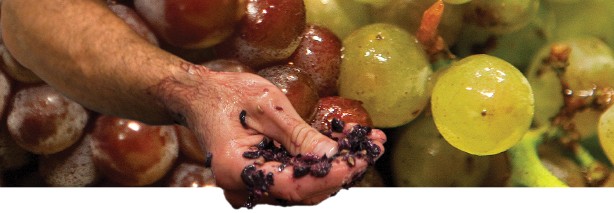
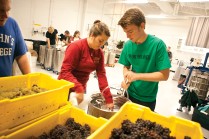
Graduate student Cline Coquard Lenerz and Johnston Moore '12 seal a fermentation barrel. See larger image
Any wine from any grape: Behind the scenes at Cornell's teaching winery
On a Wednesday evening in late September, students clad in rubber boots are pouring fresh wine samples into glasses for comparative tasting, pipetting juice to measure sugars and acids, and hoisting bins of fresh grapes up a ladder into the destemmer. Cornell's teaching winery is simultaneously a classroom, a lab, a wine cellar, a tasting room and a workshop.
The ingredients for wine are few – grapes, yeast and time – but what does it take to make a winemaker? This fall, more than 40 aspiring student winemakers are finding out, with guidance from associate professor of enology Ramón Mira de Orduña and enology lecturer Kathy Arnink.

Glassware dries in the teaching winery lab. See larger image
"Many of the things we teach in the winery are not written in books – the students have to learn by doing," says Mira de Orduña. "One of our goals is for students to feel as if the winery is a natural environment for them. That means actually understanding the winemaking process, from theories about yeast metabolism to the wrench used to tighten valves on the fermentation tanks."
The 1,800-square-foot facility, officially called the College of Agriculture and Life Sciences Teaching Winery, is the only university facility of its kind in the eastern United States. Located at the Cornell Orchards, the facility was established in 2009 with a $900,000 investment from Cornell and continues to grow with generous gifts of supplies and equipment from the wine industry.
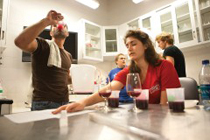
Associate professor Ramón Mira de Orduña, left, samples a glass of a students wine. See larger image
For many students, Arnink's class Grapes to Wine is their first hands-on experience with winemaking. "My students learn how much work goes into producing high-quality grapes in the vineyard," she explains. "But winemaking can turn those fantastic grapes into a mediocre wine or a fantastic wine, depending on how it's made."
To explore these possibilities, her 27 students work in groups to perform structured experiments that test the impact of specific winemaking decisions on wine flavor. One group makes wine from early and late harvests of Cayuga white, a white wine grape whose aroma intensifies from neutral to bold the longer it stays on the vine. Other students tackle technical processes, such as evaluating different methods for reducing the acidity in wines produced from cabernet franc. This year all her students are undergraduate enology and viticulture majors or minors, but she hopes an additional lab section next year will allow non-majors the opportunity to try their hand at winemaking, too.
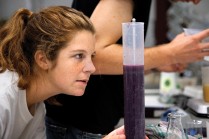
Macy Stubstad '12 uses hydrometry to measure soluble solids present in a cabernet franc. See larger image
By the time students enroll in Mira de Orduña's upper-level course, structured experiments have been supplanted by personal ambition. His students are free to explore their own winemaking style by making all the decisions from grape to bottle. They select the grape variety, harvest date, yeast strain, blending and even packaging and label design.
In the early stages of winemaking, the students are essentially farmers of yeast, the single-celled organisms that convert sugar in the fresh grape juice into alcohol – the true winemakers in the winery. Mira de Orduña teaches the students to treat the living wine carefully, like a child, meeting its needs and guarding it from potential dangers from spoilage organisms or contamination with off flavors.
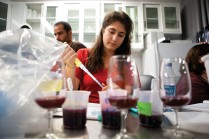
Amanda Vondras '11 dilutes samples of her wines in curvettesto measure wine color(amount of pigment).The samples will be analyzed by a spectrophotometer. See larger image
Because of this delicate relationship, the teaching lab is rarely quiet. In the first weeks of fermentation, students from both classes report daily – and some students three times a day, seven days a week – to monitor and tend the yeast. And, as with any interesting journey, winemaking can take some unexpected detours.
During class, Mira de Orduña circulates like a resident doctor on rounds. "I try to be everywhere," he admits. With a sniff, swirl, swish and a squeeze of the fermented pulp, he and the students diagnose yeast in distress. His recommendation: revive them by pumping oxygen through and adding supplemental nutrient. A few minutes later the odor of socks and cheese is gone, and a fruity aroma is abruptly revealed.
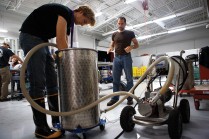
Eric Misiewicz '12 uses an impeller pump to aerate his fermenting chardonnay, which helps improve its aroma and flavor by eliminating hydrogen sulfide. See larger image
Mira de Orduña welcomes these detours. "It's a good thing. If students make mistakes, they'll remember it. If I try to make everything go flawlessly, it sets them up for problems in the future because they won't know how to respond when things don't go as planned."
At another pair of fermentation tanks, he detects the aroma of bonbons but also some bitterness, and senior Nathan Littlejohn sets up a bladder press to gently separate the juice from the skins and seeds. Minutes later, garnet juice is pumped into a fresh tank.
"It tastes like wine," Littlejohn announces with pride and just a hint of surprise.
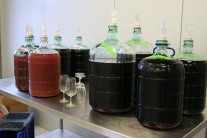
Some of the first wines produced at the teaching winery last spring (in bottles called "carboys"). Photo by Craig Cramer. See larger image
Months from now, when the fermentations are complete and the wines have been clarified, blended and bottled, students from both classes will evaluate their wines and the winemaking choices that shaped them. They'll leave the teaching winery behind, a step closer to being winemakers and ready to intern in wine cellars around the world.